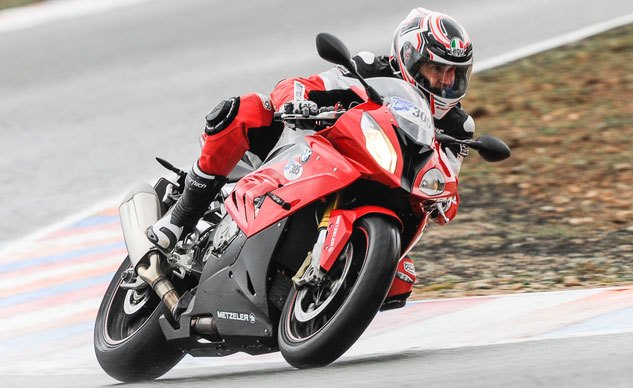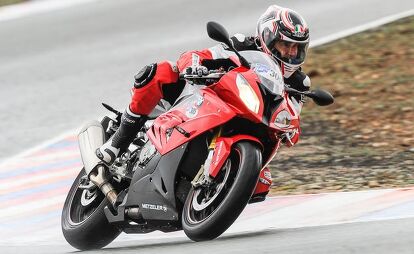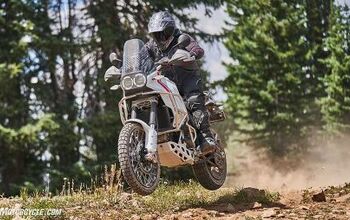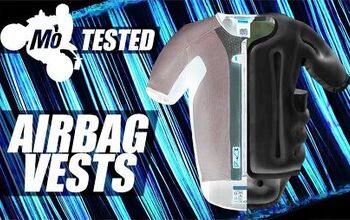Metzeler Sportec M7 RR Review

Broadening the sporting tire's performance envelope
As I slide on my back, the wet Spanish dirt at the outside of Almeria’s Turn 6 rushing up to greet me, I take a moment to ponder the error of my ways. It’s funny how time appears to slow down once one fully accepts that control has been ceded to powers greater than ourselves. Rewinding my current situation to just a fraction of a second earlier, my sin is revealed, standing before me like an old friend, arms open. With my no longer pristine, custom Pilot leathers providing tactile proof through my back protector of why I shouldn’t be allowed to have nice things, I try to ignore the 2015 BMW S1000RR skidding to my left and slightly in front of me. (So much more can happen before it grinds to a halt.) I can’t help but think how this has all happened before. How, once again, a single thought has spelled disaster. In the past, the thoughts were as simple as “I love this track!” or “I’ve finally figured out this corner!” This time, I merely thought, “The Metzeler Sportec M7 RRs have so much grip in the rain. Soon, I’ll be dragging knee!” Instantaneously, I was – only not in the manner I was expecting.
Metzeler gathered the international moto-press to Almeria, Spain, to sample its latest generation track tires, the Racetec RR K1, K2, and K3. Unfortunately, Mother Nature had other plans. When we woke on the morning of the test with wind and rain pelting the hotel, the event organizers, in a move that showed remarkable flexibility, acknowledged that the conditions were hardly conducive to poking at the limits of street-legal racing rubber – though they noted that the tires could still be used in the rain. However, they explained, the rain-soaked pavement would provide an ideal environment for demonstrating the performance of the other member of the Metzeler RR family, the new Sportec M7 RR. So, as clusters of rain cells moved through the area with occasional flashes of lightning in the distance, Metzeler lined up the S1000RRs and sent us out on the track to let the Sportecs display their mettle.
Taking Aim
When developing the successor to the popular but aging Sportec M5 Interact supersport street tire, Metzeler’s engineers turned to roadracing for inspiration – not the kind performed on the billiard-smooth pavement of purpose-built racing venues but the uber-manly roadracing that takes place on public roadways around the world. You know, the Isle of Man TT or the Irish North West 200 or Macau Motorcycle Grand Prix, featuring names like Guy Martin, Josh Brookes, and Michael Rutter. Here is where the limits of the tire technology could be explored over widely variable road surface conditions, just like those experienced by street riders – only with the volume turned up to 11.
“Sportec M7 RR is dedicated to all those riders with a sporty riding style, that use their bikes in all conditions, from the everyday urban environment to the weekend trip on twisty roads, those who look for grip with any road condition, weather and temperature.” – Metzeler press materials
The rider above could almost be described as the motorcyclist who does everything on a sporting motorcycle, but really the definition outlines the areas of focus for the Sportec. Metzeler wanted the Sportec to perform well no matter what the conditions, leading the engineers to focus on improving the M5’s already good performance in handling, grip, and wear. These three are achieved through the interactive relationship amongst the tread profile, pattern and compound.
Feeling Groovy
Perhaps the greatest challenge Metzeler set for the M7 RR was the goal of grip not just on dry pavement but on dirty or wet pavement, as well. The battle for this balance largely takes place in the land/sea percentages on the tread in addition to the shape and location of the grooving. Compared to the M5, the M7’s front land/sea ratio increased 2.1% to 14.7% but dropped 1.5% to 11.1% in the rear. The logic behind these changes is that the front plays a more important role in clearing water from the pavement with the rear tire reaping the benefits. Additionally, the location of the grooves favors the portion of the tread utilized in the initial and mid-point in the bike’s lean angle.
As the bike leans more onto the side of the tire, the tread’s lateral grooves increase their width while reducing depth to improve the water clearing capabilities of the tread. This change also helps reduce tread distortion and, consequently, improves the tire’s wear characteristics. Similarly, the longitudinal grooves on the M7’s rear tire are interrupted by compound bridges that improve the tread stability and provide better grip for the accelerating thrust. Finally, the tread of both the front and rear tires offer a center strip with no grooves, for optimal acceleration and braking.
Compounding the Issue
While the tread and the profile of the tire play an important role in a tire’s grip, the biggest gains in the Sportec’s performance come from advances in tire compound technology. The new compounds are designed to create mechanical and chemical grip with the road surface.
In the past, a tread’s silica content was primarily associated with the tire’s wet weather grip, while carbon black was used for improved dry grip and high-temperature performance. Well, it appears that technology developed in sport-touring tires is trickling up to supersport tires for the M7 RR. Metzeler claims that its patented mixing process allows for the use of 100% silica in both high temperature, dry environments (normally the domain of carbon black) and cold, wet conditions. The front tire’s tread is 100% silica, but the rear, in a nod to the extreme forces to which it is subjected under acceleration, features a center section, approximately 45mm wide, that uses 70% silica for improved durability. The end result is an expansion of the tire’s performance envelope to include more than just perfect, dry pavement with warm rubber. Instead, the myriad of conditions expands dramatically – as evidenced by my day on the wet pavement of Almeria.
Competitor: Dunlop Q3 Tire Review
The profile of tires determines their handling dynamics, and the M7 RR’s profiles have changed from the M5’s largely to create a flatter shoulder and a larger footprint at maximum lean. The larger center radius creates a steeper initial curve for responsive steering before flattening out towards the shoulder. The internal structure of the tires that constitutes the Interact technology has also been updated in the M7 though the theory is the same as described in our M5 Interact review. The carcass’ Rayon has also increased in density and stiffness to retain its shape under higher strain loads than the M5.
Where the Leather Meets the Road
There’s a special kind of pain in the pit of my stomach reserved for those times when I feel the pressure to not f**k up. Having it switch to don’t f**k up again ramps stomach acid level up exponentially – bonus levels were also awarded for being the only journalist who had gone pavement surfing. The bugaboo was that, when I crashed, I was at the back of a three-bike freight train on almost exactly the same line. As we passed the apex of the corner, at neutral throttle, I made an adjustment to slightly tighten my line for a better exit and setup for the next corner – then the front tire said no.
With each session after my crash, my confidence in the M7 RRs returned. Once warmed up – which seemed only to take two laps in the wet – the tires turned in neutrally. They offered plenty of cornering grip. In fact, Metzeler couldn’t have fashioned a better example of how well these tires perform in the wet. We rode well above the speeds that any sane rider would attempt on the street in the rain, and with the exception of myself, nobody took a roll in the mud. One rider, at the end of the day’s riding, said that his S1000RR’s datalogger showed that he had achieved 50° lean at one point in a session. I, with my reduced-sized testes, can’t report any exact numbers, but the lean angles I achieved by the end of the day were some much-needed salve for my sore ego.
Tire performance in the rain isn’t the only measured by lean angle, though. On the brakes, the M7 RRs provided a surprising level of wet pavement stopping power. On the back straight, I was typically hitting an indicated 240 kph (149 mph) and was able to haul the bike down for one of the slowest corners on the course with tremendous authority. On a couple of occasions I could feel the ABS briefly intercede on my behalf (thank you, BMW), but that speaks to the confidence I had in the front end despite my post-crash eunuch status. Entering that straight had me WFO while still leaned over with the TC light flashing as the BMW generated accelerative forces I wouldn’t have thought possible on a street tire in the wet. I only experienced a couple wiggles while leaned over for the remainder of the day. By the end of the track portion of the day, I was tempting fate by again riding with a smile on my face.
Competition: Pirelli Diablo Rosso Corsa Review
The return trip to the hotel was a street ride on dirty roads ranging from soaking wet to almost dry. In these transitional conditions, which can be even more treacherous than active rain, the Metzelers performed quite well, only squirming on extremely dirty pavement. When they did slip a bit, they regained their composure quickly and without drama. Thanks to some foresight on Metzeler’s part, we had a short, dry, street ride the day before the track event. (Metzeler also shipped me a set of M7 RRs for my R6, allowing me to log a few hundred miles on the rubber.)
For street riding at a sporting pace, every characteristic I liked about the M7s in the wet is true – only more so. Turn-in is quick and neutral, with the bike going from straight up to full lean – or anywhere in between – in an instant. Since street riding is a constant management of unknowns, the tires didn’t complain a bit at being asked to alter lines mid-corner. When standing the bike up and tossing it back over to avoid rocks encountered on blind curves, the M7s remained unflappable. They traversed sand easily with little slip. I can’t comment on the longevity, but Metzeler claims a 20% increase in mileage over the M5 Interacts. More mileage is always welcome!
Metzeler M7 RR Available Sizes | |
| Front | Rear |
| 110/70 ZR 17 | 150/60 ZR 17 |
| 120/60 ZR 17 | 160/60 ZR 17 |
| 120/70 ZR 17 | 180/55 ZR 17 |
| 190/50 ZR 17 | |
| 190/55 ZR 17 | |
| 190/55 ZR 17 | |
| 200/55 ZR 17 | |
Counting the Beans
Metzeler considers itself a premium motorcycle tire brand, and its representatives are quick to note that Metzeler is the only motorcycle tire manufacturer that produces only motorcycle tires. Consequently, they feel they “get” motorcyclists and their needs more than the other brands. Regardless, the Metzeler M7 RR signals an advance in supersport street tire performance that can also pull track-day duty in a pinch. The wet-weather track ride I partook in Almeria highlights the M7 RR’s ability to warm up quickly and provide ample grip.
The Metzeler M7 RR tires are now available in all sizes throughout the US. The M7 RR front tires will retail for $162–169, lower than Dunlop Q3 Sportmax, Michelin Pilot Power 3, Pirelli Diablo Rosso Corsa; more than Bridgestone Battlax Hypersport S20. Rear rubber carries MSRPs of $195-$274, which is less than Dunlop Q3 Sportmax, Michelin Pilot Power 3, Pirelli Diablo Rosso Corsa; more than Bridgestone Battlax Hypersport S20.

Like most of the best happenings in his life, Evans stumbled into his motojournalism career. While on his way to a planned life in academia, he applied for a job at a motorcycle magazine, thinking he’d get the opportunity to write some freelance articles. Instead, he was offered a full-time job in which he discovered he could actually get paid to ride other people’s motorcycles – and he’s never looked back. Over the 25 years he’s been in the motorcycle industry, Evans has written two books, 101 Sportbike Performance Projects and How to Modify Your Metric Cruiser, and has ridden just about every production motorcycle manufactured. Evans has a deep love of motorcycles and believes they are a force for good in the world.
More by Evans Brasfield











































Comments
Join the conversation
I have the Metzler M5 on my bike and they are great perfoermers. Another 4K and it would be time again to change the tyres. Thanks to the review I would be using the M7. The only thing I would like metzler to do is maybe increase the tyre life :) or maybe it is just wishfull thinking.
So, I'm confused. In the first paragraph, did you wreck on a set of M7RR's?